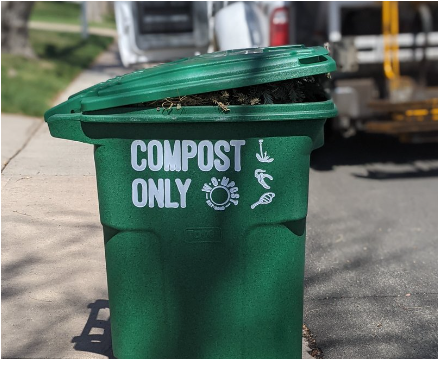Mitigation: Waste
Climate Goals - Mitigation: Waste
Recycling and waste prevention reduce greenhouse gases in a number of ways. Recycling limits energy use by limiting the need to produce goods from brand-new materials. It also lowers the need to extract materials through activities such as mining, which saves even more energy. When energy consumption is reduced, fewer fossil fuels are burned, reducing the amount of carbon dioxide released into the atmosphere.
Preventing waste through reuse of items, reduced packaging, or buying fewer things is even more effective at reducing carbon emissions. Keeping waste out of landfills reduces methane emissions. Methane is the second most abundant greenhouse gas in the atmosphere after carbon dioxide, and is 25 times more potent. Because methane gasses are released when organic materials such as food waste break down, keeping organic materials out of landfills also supports greenhouse gas reductions. In addition, compost from organic materials provides a number of benefits.
State of Colorado Waste Diversion & Reduction – Goals & Actions
The Colorado Solid and Hazardous Waste Commission adopted ambitious statewide municipal solid waste diversion goals of 35% by 2026 and 45% by 2036. Diversion means keeping waste out of landfills. A 35% increase in waste diversion would result in the equivalent emissions reduction of removing more than 1.1 million cars from the road for one year, while a 45% diversion would be the equivalent of cutting more than 1.4 million cars for one year (based on a 2021 baseline). In 2021, more than 2 million metric tons of greenhouse gas emissions were prevented through Colorado’s waste diversion efforts. These greenhouse gas savings have the same impact as removing 428,897 cars from Colorado roads for one year.
Key Priorities
Creating a Circular Economy
The goal of the State’s Circular Economy Development Center (CEDC) is to expand existing markets and create new markets for recyclable materials in Colorado. To accomplish this, the state is not only working with the recycling industry, but also embracing manufacturing, transportation, and other sectors to create a circular economy. A circular economy is different from our current “linear” economy, where natural resources are extracted, made into products, and then discarded. In a circular economy, products are purposefully designed for durability, reuse, remanufacturing, and recycling to keep materials in use and reduce the new extraction of natural resources.
Designing for Less Waste
Signed into law in June 2022, the Producer Responsibility (EPR) Program requires companies that sell products in packaging and paper products to fund a statewide recycling system to recycle those materials. In addition to expanding recycling access, producers will pay dues determined by the product's design. Known as eco-modulation, this approach encourages producers to create products that will:
- Reduce the amount of packaging materials.
- Enhance the recyclability or the value of the materials.
- Use high levels of post consumer recycled material.
- Make it possible to reuse and refill containers.
Recycling & Composting
The state offers two recycling grant programs: the Recycling Resource Economic Opportunity (RREO) program and the Front Range Waste Diversion (FRWD) Enterprise program. RREO provides grants and rebate funding statewide for projects that reduce, reuse, and recycle commodities and compost organics, while the FRWD program focuses on waste diversion in the Colorado Front Range. Legislation that created the FRWD program notes that recycling “is one of the fastest, easiest, and most cost-effective ways to reduce greenhouse gas emissions,” and charges the program with ambitious waste diversion goals.




